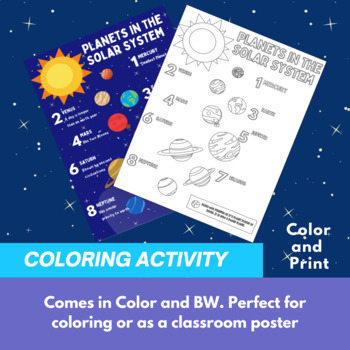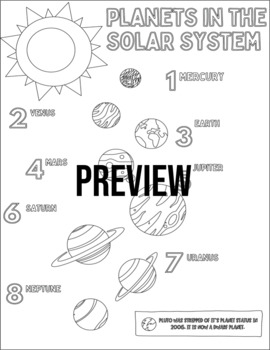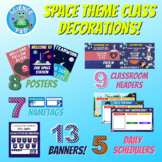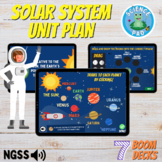Planets of the Solar System | Coloring Activity | Craft | Poster | Decor | Space
Science Pad
230 Followers
Grade Levels
PreK - 8th
Subjects
Resource Type
Standards
NGSSMS-ESS1-2
NGSSMS-ESS1-3
Formats Included
- PDF
Pages
6 pages
Science Pad
230 Followers
What educators are saying
Thank you so much for this product. This worked great for my 5th grade class. It was easy to download and use. Great time saver for me!
Also included in
- Summer Science Camp - 23 activities - Experiments, Crafts, Coloring, Lesson Plan Learn important life skills and STEM lessons with the Campfire Science Camp. Our workbooks are filled with camping activities that diverse range from experiments, science crafts, coloring activities, experiments. TherePrice $19.99Original Price $39.95Save $19.96
- Back to School Science Classroom Decorations and Decor | Banners BundleCreate a solar system in your classroom with this fun bundle. There are a large variety of items including google classroom headers, Large and small classroom banners, Posters and Binder Covers, Space Coloring Activities, DailyPrice $14.00Original Price $20.98Save $6.98
- Solar System Boom Cards Unit Plan | Self-paced Lesson Plan | Moon Sun GravityLooking for a self-paced solar system unit plan for distance learning? Skip the solar system printables and worksheets, these interactive digital boom cards gamify learning. Students will learn about the moon, gravity, thePrice $15.00Original Price $19.99Save $4.99
Description
Planets of the Solar System Coloring Activity - Digital and Print Version
Try out this fun and engaging coloring activity. Students will research and find a few facts about each planet and list them next to the illustrations. They will then color the planets of the solar system. This space themed coloring activity is great for getting students to research planets as well as helping them remember the order of the planets.
Topics: Planets of Solar System, Earth, Mars, Venus, Mercury, Jupiter, Neptune, Dwarf Planet Pluto, Uranus
Features
Color Version of Planets
- Perfect for Classroom poster, infographic, or decor
- Great for showing students information and order of the planets before they start their coloring activity
Printable Drawing Worksheet
- Students will fill in a few facts about each planet through independent research or copying the Color version
- Students will color the illustrations of the planets
Total Pages
6 pages
Answer Key
N/A
Teaching Duration
N/A
Report this resource to TPT
Reported resources will be reviewed by our team. Report this resource to let us know if this resource violates TPT’s content guidelines.
Standards
to see state-specific standards (only available in the US).
NGSSMS-ESS1-2
Develop and use a model to describe the role of gravity in the motions within galaxies and the solar system. Emphasis for the model is on gravity as the force that holds together the solar system and Milky Way galaxy and controls orbital motions within them. Examples of models can be physical (such as the analogy of distance along a football field or computer visualizations of elliptical orbits) or conceptual (such as mathematical proportions relative to the size of familiar objects such as students’ school or state). Assessment does not include Kepler’s Laws of orbital motion or the apparent retrograde motion of the planets as viewed from Earth.
NGSSMS-ESS1-3
Analyze and interpret data to determine scale properties of objects in the solar system. Emphasis is on the analysis of data from Earth-based instruments, space-based telescopes, and spacecraft to determine similarities and differences among solar system objects. Examples of scale properties include the sizes of an object’s layers (such as crust and atmosphere), surface features (such as volcanoes), and orbital radius. Examples of data include statistical information, drawings and photographs, and models. Assessment does not include recalling facts about properties of the planets and other solar system bodies.







